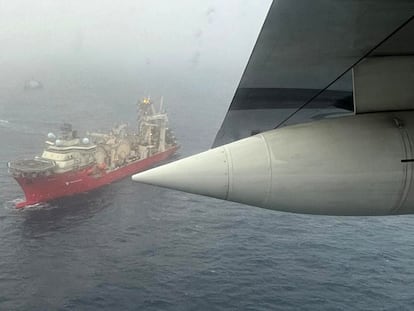‘Catastrophic implosion’ destroyed ‘Titan’ submersible, US Coast Guard confirms
Debris found near the wreckage of the ‘Titanic’ during the search for the vessel has been identified as the remains of the OceanGate submarine, which buckled due to external pressure
The search and rescue operation to locate the Titan submersible reached its final, definitive phase Thursday, with the discovery of five large pieces of debris about 500 meters from the bow of the Titanic, the destination of the submersible when it lost contact last Sunday. The small vessel had an oxygen supply of 96 hours, leading to an intensified international search effort Wednesday in the waters of the North Atlantic, where an armada of ships and remote-controlled devices scanned the area, including three robots dedicated to combing the zone where on Tuesday and Wednesday noises of unknown origin were detected. Another, designed to lift heavy loads, was deployed to refloat the Titan if it was found. Rescuers have now confirmed it had earlier disintegrated on the seabed, taking with it the lives of its five occupants. One of the robots, controlled remotely by the Canadian ship Horizon Arctic, located the wreckage at a depth of 3,800 meters on Thursday.
The Titan broke up due to a “catastrophic implosion” caused by external pressure on the vessel, a cylinder-shaped cabin measuring just over 6.5 meters in length, 2.8 meters in width and 2.5 meters in height. Its size permitted underwater expeditions at a relatively low cost, despite the structural and certification risks that some experts had previously warned about. An expensive toy, at $250,000 per passenger, ended up transformed into a floating coffin.
Among the five “major” pieces of the Titan’s outer skin that were found, in the words of U.S. Coast Guard Rear Admiral John Mauger, were the nose cone, the tail cone, the front end bell of the pressure hull and its aft end, as confirmed by Paul Hankins, a salvage expert with the U.S. Navy, which detected what it considered to be an implosion last Sunday without linking it to the missing device.
“This was a catastrophic implosion of the vessel, which would have generated a significant broadband sound down there that the sonar buoys would have picked up,” said Mauger, who did not provide timeline data on the event. Listening devices in the area did not pick up any indication of such a catastrophic failure, as previously reported, while underwater noises detected by Canadian reconnaissance aircraft on Tuesday and Wednesday do not appear to be related to the Titan’s collapse. “While we were prosecuting the search, we had listening devices in the water throughout and did not hear any signs of catastrophic failure from those,” Mauger added at Thursday’s press conference. “This is an incredibly unforgiving environment down there on the sea floor. The outpouring of support in this highly complex search operation has been great appreciated. Our most heartfelt condolences go out to the friends and loved ones of the crew.”
The co-founder of OceanGate, Guillermo Söhnlein, told the BBC that there was likely an “instantaneous implosion” of the submersible, among whose passengers was OceanGate CEO Stockton Rush. “If that’s what happened it would have happened four days ago,” he added. The priority of the search operation is now to find and recover the bodies of the passengers — Stockton; Paul-Henry Nargeolet, a renowned Titanic expert; Hamish Harding, a world-record holding adventurer, and Shahzada and Suleman Dawood, two members of one of Pakistan’s wealthiest families — while determining the sequence of events that led to the fatal outcome.
The Titan was reported overdue Sunday afternoon about 435 miles (700 kilometers) south of St. John’s, Newfoundland, as it was on its way to where the iconic ocean liner sank more than a century ago. OceanGate Expeditions has been chronicling the Titanic’s decay and the underwater ecosystem around it via yearly voyages since 2021.
“A needle in a haystack situation”
Dr. Rob Larter, a marine geophysicist with the British Antarctic Survey, emphasized the difficulty of finding something the size of the Titan. “You’re talking about totally dark environments,” in which an object several dozen feet away can be missed, he said. “It’s just a needle in a haystack situation unless you’ve got a pretty precise location.”
Newly uncovered allegations suggest there had been significant warnings made about vessel safety during the submersible’s development.
At least 46 people successfully traveled on OceanGate’s submersible to the Titanic wreck site in 2021 and 2022, according to letters the company filed with a U.S. District Court in Norfolk, Virginia, that oversees matters involving the Titanic shipwreck.
However, one of the company’s first customers characterized a dive he made to the site two years ago as a “kamikaze operation.”
“Imagine a metal tube a few meters long with a sheet of metal for a floor. You can’t stand. You can’t kneel. Everyone is sitting close to or on top of each other,” said Arthur Loibl, a retired businessman and adventurer from Germany. “You can’t be claustrophobic.”
During the two-and-a-half-hour descent and ascent, the lights were turned off to conserve energy, he said, with the only illumination coming from a fluorescent glow stick.
The dive was repeatedly delayed to fix a problem with the battery and the balancing weights. In total, the voyage took ten and a half hours. The submersible had seven backup systems to return to the surface, including sandbags and lead pipes that drop off and an inflatable balloon.
Nicolai Roterman, a deep-sea ecologist and lecturer in marine biology at the University of Portsmouth, England, said the disappearance of the Titan highlights the dangers and unknowns of deep-sea tourism. “Even the most reliable technology can fail, and therefore accidents will happen. With the growth in deep-sea tourism, we must expect more incidents like this.”
Sign up for our weekly newsletter to get more English-language news coverage from EL PAÍS USA Edition
Tu suscripción se está usando en otro dispositivo
¿Quieres añadir otro usuario a tu suscripción?
Si continúas leyendo en este dispositivo, no se podrá leer en el otro.
FlechaTu suscripción se está usando en otro dispositivo y solo puedes acceder a EL PAÍS desde un dispositivo a la vez.
Si quieres compartir tu cuenta, cambia tu suscripción a la modalidad Premium, así podrás añadir otro usuario. Cada uno accederá con su propia cuenta de email, lo que os permitirá personalizar vuestra experiencia en EL PAÍS.
¿Tienes una suscripción de empresa? Accede aquí para contratar más cuentas.
En el caso de no saber quién está usando tu cuenta, te recomendamos cambiar tu contraseña aquí.
Si decides continuar compartiendo tu cuenta, este mensaje se mostrará en tu dispositivo y en el de la otra persona que está usando tu cuenta de forma indefinida, afectando a tu experiencia de lectura. Puedes consultar aquí los términos y condiciones de la suscripción digital.
More information
Archived In
Últimas noticias
Most viewed
- Sinaloa Cartel war is taking its toll on Los Chapitos
- Oona Chaplin: ‘I told James Cameron that I was living in a treehouse and starting a permaculture project with a friend’
- Reinhard Genzel, Nobel laureate in physics: ‘One-minute videos will never give you the truth’
- Why the price of coffee has skyrocketed: from Brazilian plantations to specialty coffee houses
- Silver prices are going crazy: This is what’s fueling the rally










































